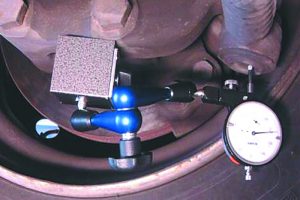
Wayne McCluskey, Technical Training Manager at ZF Services UK, looks at the key considerations for workshops when servicing steering systems in commercial vehicles, and the techniques that should be used when testing parts.
“Deciding when to replace components can be difficult. Too early and both the workshop and the end customers have not received value for money, but too late and the system could fail completely and compromise safety. Ball joints and steering shafts are components that are frequently returned unnecessarily and could benefit from testing.”
In comparison to other commercial vehicle components, the steering system is relatively simple. However, as one of the main reasons for MOT failure, appropriate installation and maintenance is necessary to limit CV downtime and prevent unnecessary labour and component costs.
Steering for commercial vehicles can be challenging because of the loads involved, with any heavy impact that exceeds the design load potentially causing permanent damage to the system, and compromising performance and vehicle stability.
Who’s liable?
Workshops and technicians are legally liable for their actions and this should be considered when repairs are undertaken. A vehicle must be fixed and maintained with ‘reasonable care and skill’ and all parts used must be fit for purpose. For some companies, it may be tempting to use a second-rate part or not undertake appropriate checks before the vehicle leaves the workshop, in order to save time and resources. However, this could have damaging implications.
When to replace worn components
Deciding when to replace components can be difficult. Too early and both the workshop and the end customers have not received value for money, but too late and the system could fail completely and compromise safety. Ball joints and steering shafts are components that are frequently returned unnecessarily and could benefit from testing.

The method for assessing wear in each ball joint type is different. For example, an old version Lemförder ball joint can be tested using the LMI 27351.01 testing tool, whereas the current version must be assessed in-situ. When testing for wear, care must be taken not to exert excessive force to the ball joint, as testing in this way may damage the ball joint components and give an inaccurate impression of wear.
Always replace in pairs
Although replacing parts in pairs has been the advice communicated by the industry for many years, some end users do still see it as a ruse for a workshop to sell more products. For this reason, customers should be provided with all the information about the potential risks and why it will save them money in the long- term. When damage does occur in steering systems, replacing axle pairs will maintain stability and safe handling.
Careful handling
Spare components from the OEM are produced with the greatest attention to detail, and in some cases, they are 100% tested throughout the production process. However, components are susceptible to damage during transportation or if improperly handled, meaning they should be inspected before installation. Components can be easily damaged in the installation process too – for example, with the plastic boots and bellows that form part of a ball joint component, which can be accidentally holed. In this example, the component will fill up with water and grit from the road, causing premature joint failure.

Applying too much force to joints when testing is also a common cause of damage which may not be apparent as the vehicle leaves the workshop, but can speed up failure. For example, some joints have been redesigned to feature a plastic cup rather than a spring which was common in years gone by. Some technicians still use the same testing process however, applying the same pressure as before causing the cup to snap and resulting in excessive free play.
Unspecified parts
Like all spare parts from ZF Services, Lemförder chassis and steering components offer a ‘fit and forget’ concept. However, secondary quality products from the spare parts market may differ and it’s recommended to always replace ‘like for like’, regardless of brand. For example, rubber bushes which have been copied are often made from sub-standard rubber and are likely to deteriorate quicker than OEM quality steering and suspension components.
“With steering systems set to become more complex through emerging technologies such as collision avoidance, lane assist and adaptive cruise control, workshops will need to ensure they are up- to-date with changing parts, and the way they service and repair commercial vehicles.”
Appearance can be copied but performance can’t. For example, in poor quality components, the microstructure in metals can be incorrect, leading to premature failure compared to genuine parts, making the use of cheaper alternatives a false economy. Another example is the rubber bushes in suspension which must be precisely aligned. Cheaper alternatives are made quickly and without care, meaning the required rubber density is often incorrect, with cut-outs and locating pins misaligned. These must then be levered in with force ‘to fit’, but ultimately fail early as the incorrect alignment causes the bushes to wear out.
Rapidly growing challenges in the transport and logistics sector demand solutions which save costs and are more energy efficient. With steering systems set to become more complex through emerging technologies such as collision avoidance, lane assist and adaptive cruise control, workshops will need to ensure they are up-to-date with changing parts, and the way they service and repair commercial vehicles.








